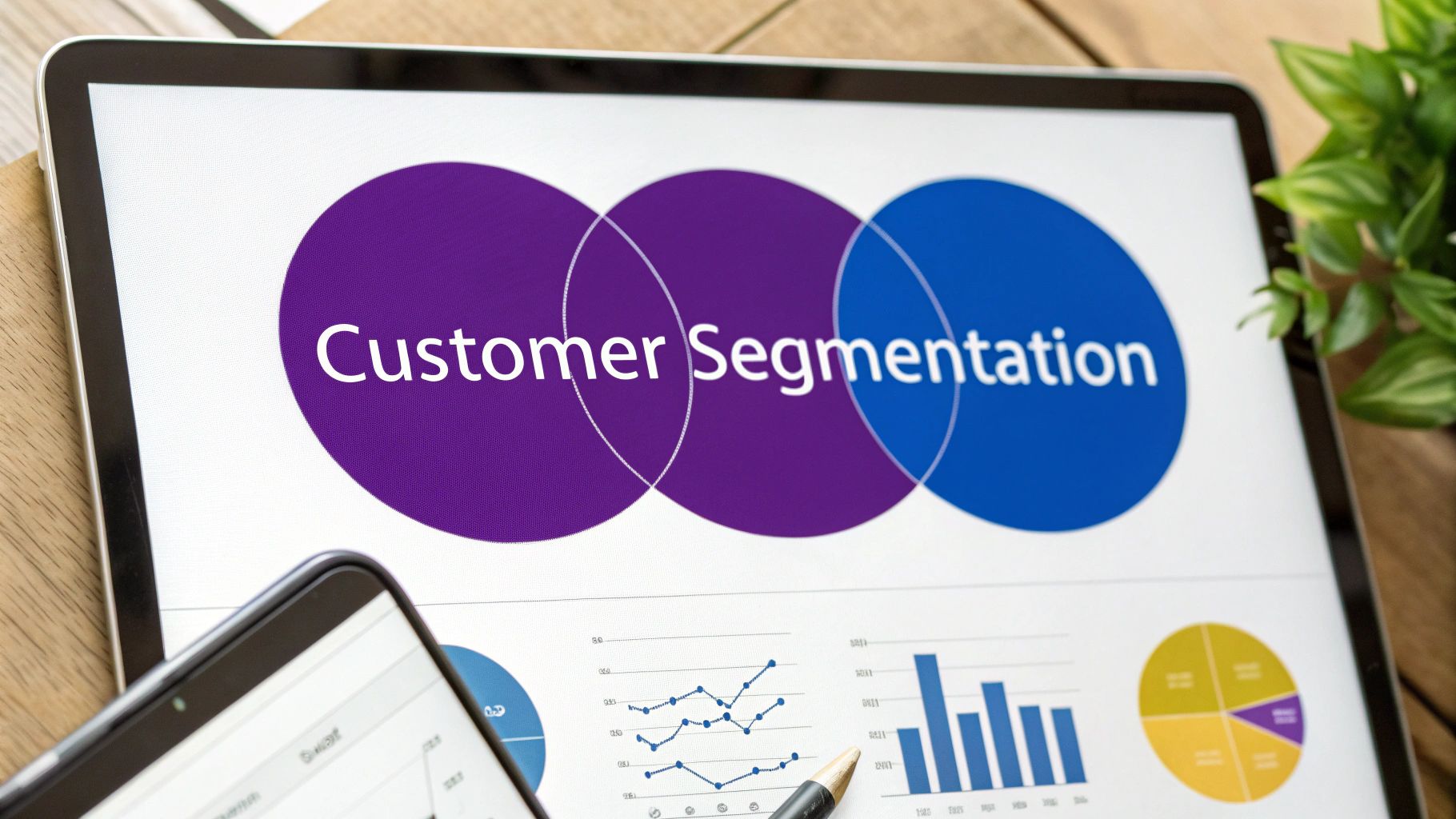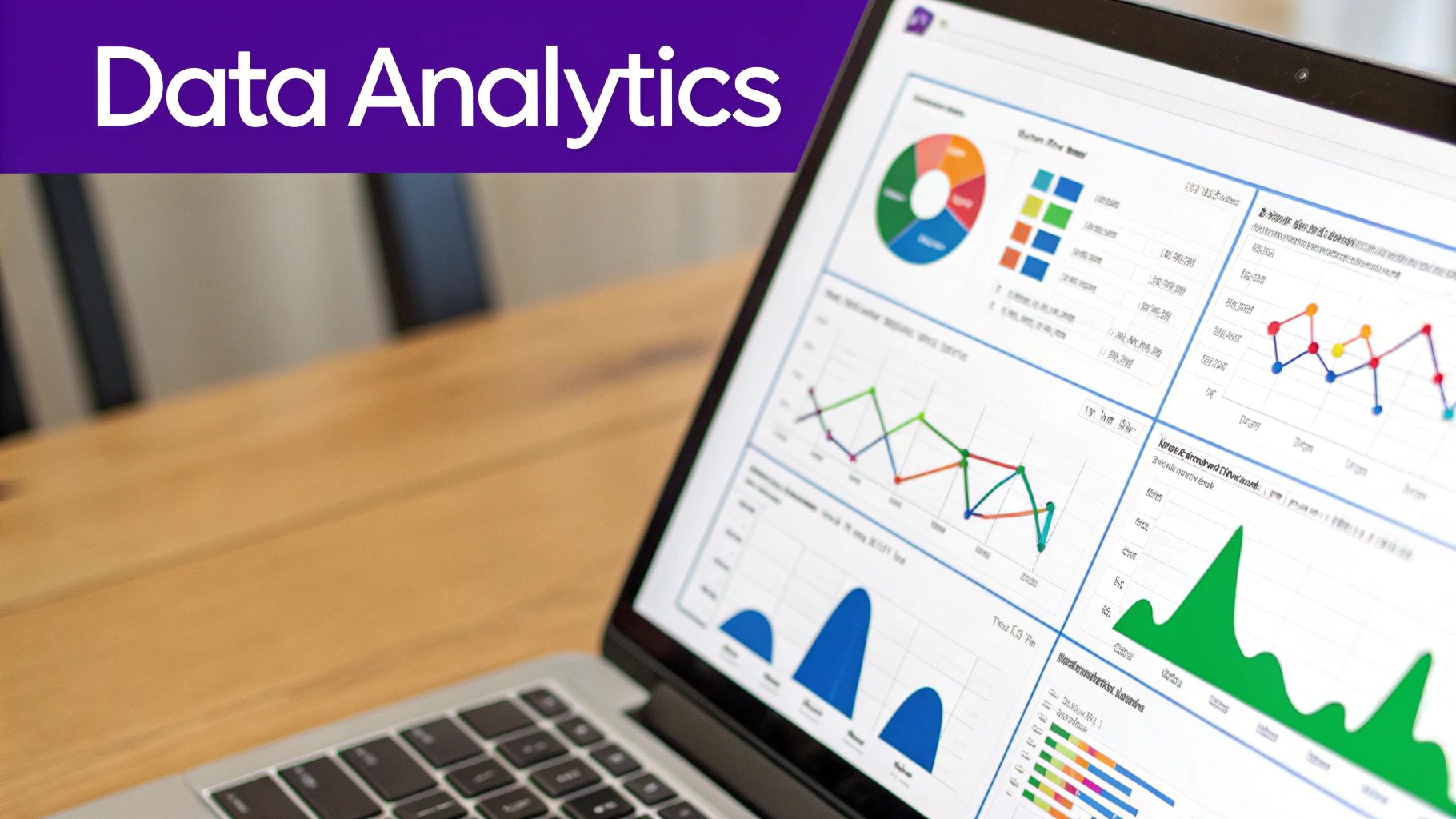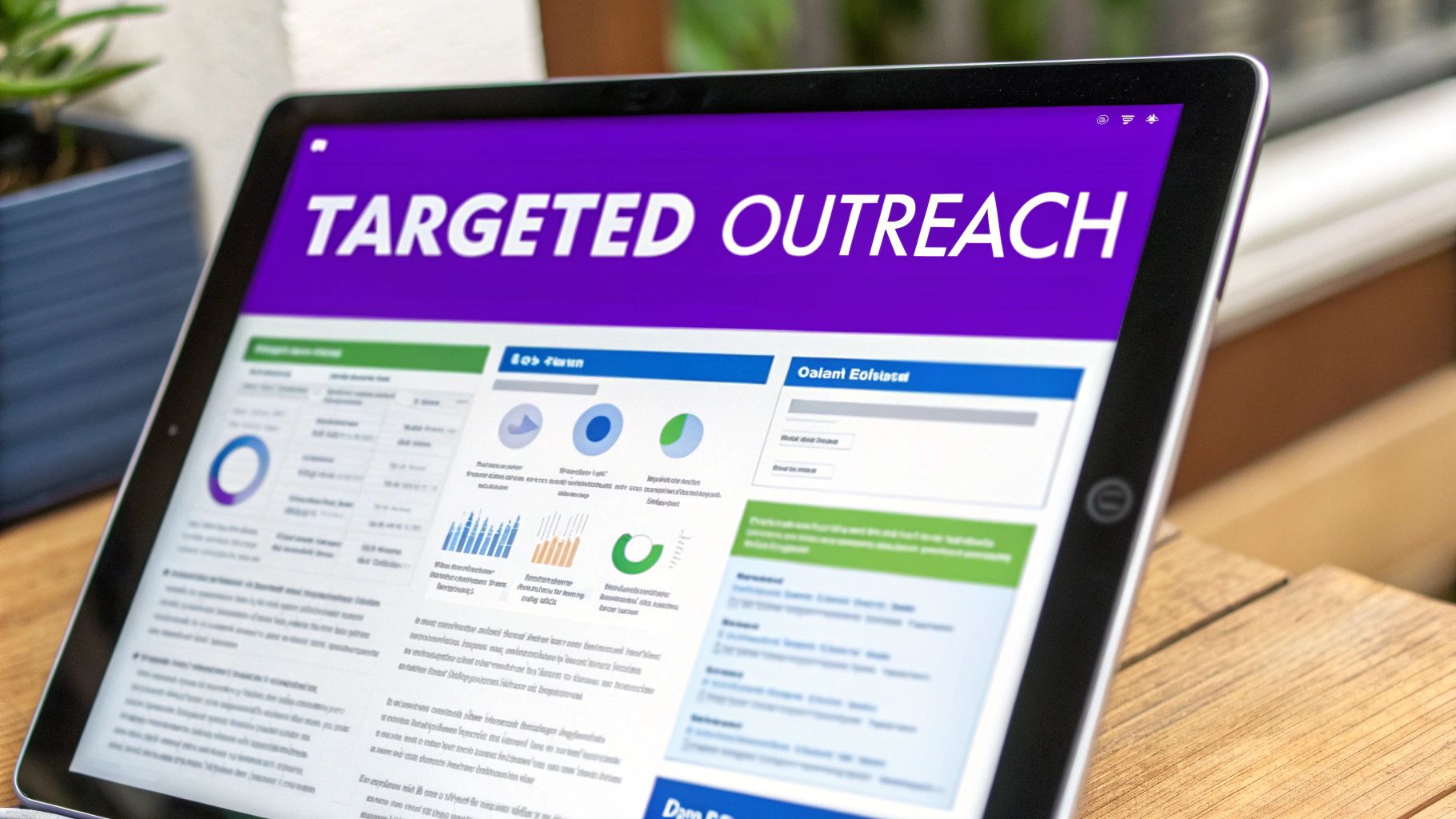The Ultimate Guide to Customer Segmentation Strategies: Proven Methods for Business Growth

Understanding Customer Segmentation That Actually Works

Smart businesses know that customer segmentation is more than just a marketing tool - it's essential for growth. Rather than simply grouping customers into broad categories, effective segmentation requires a deep understanding of how customer needs, behaviors, and motivations connect with each other.
Why Traditional Segmentation Methods Still Matter
Demographic segmentation continues to provide valuable insights for businesses. By grouping customers based on characteristics like age, gender, income, and location, companies can better target their offerings. For example, a clothing retailer can create distinct marketing messages for different age groups. Studies show that demographic segmentation can boost marketing campaign effectiveness by up to 30% when messages connect with the right audience. Learn more about segmentation strategies.
Embracing the Power of Multi-Dimensional Segmentation
The most effective segmentation goes beyond basic demographics. By combining behavioral data (like purchase history), psychographic information (such as interests and values), and geographic factors, companies build a more complete picture of their customers. For instance, analyzing website browsing patterns reveals valuable details about individual preferences that demographics alone miss.
Building Actionable Segments
When you combine multiple data points, you create segments you can actually use. Think of it as assembling puzzle pieces - each type of information adds clarity to your understanding of the customer. This allows you to personalize everything from product recommendations to marketing emails in ways that truly connect. By spotting patterns in how different customer groups behave, you can anticipate their needs and create experiences that build lasting relationships and drive sales.
Making Data-Driven Segmentation Work for You
Smart customer segmentation is essential for growing your online store. Rather than guessing what different customer groups want, you can use real data to understand their needs and preferences. This allows you to make informed decisions about everything from product recommendations to marketing campaigns.
Practical Strategies for Data Collection and Analysis
The foundation of good segmentation is gathering the right information. Shopify, which Wand Websites specializes in, provides built-in tools to track customer demographics, purchase patterns, and browsing behavior. Your email marketing platform can add another layer of insights through engagement metrics like open and click rates.
But having data isn't enough - you need to use it strategically. For instance, if you notice certain products are often bought together by specific customer groups, you can create targeted bundle offers just for them. This turns raw numbers into real business opportunities.
Avoiding Common Pitfalls
Watch out for data silos - when important customer information is spread across different systems and can't paint a complete picture. Also be mindful of data quality. Bad or incomplete data leads to flawed customer groups and wasted marketing efforts. Our team at Wand Websites helps prevent these issues by bringing your data together and setting up good data practices.
Real-World Examples and Case Studies
Take Minter & Richter, one of our clients. After moving to a Shopify store optimized by Wand Websites, they saw their revenue double. How? We helped them analyze how customers used their new site and adjusted their product suggestions and marketing to match different customer needs. Their success shows what's possible when you combine smart website design with data-driven customer insights.
Scaling Your Data Analysis
As you grow, you'll need your data tools to grow with you. This might mean adding more detailed analytics or automating some of your marketing. Wand Websites provides ongoing support to help adjust your customer grouping approach as your business expands. We make sure your data keeps driving results and boosting your bottom line. The right data strategy helps you give customers what they want, market more effectively, and steadily grow your business.
Turning Customer Behavior Into Strategic Advantage

Smart businesses know that understanding customers takes more than just basic demographic data. The real insights come from studying why people make purchases and what drives their decisions. By analyzing customer behavior patterns, companies can better predict and serve customer needs.
Identifying Key Behavioral Patterns
Understanding how customers interact with your business reveals valuable patterns. For instance, tracking purchase frequency shows which customers buy regularly versus occasionally. Website analytics tell you what products people view most and how long they spend browsing different pages. This data paints a clear picture of customer interests and helps shape targeted promotions.
Transforming Insights Into Actionable Strategies
Once you understand customer behavior, you can create marketing that really connects. This could mean sending personalized emails based on past purchases or offering special deals to your most loyal customers. For example, if data shows customers often buy related items like coffee and filters together, you can create bundle deals they'll love.
The Power of Customer Lifetime Value
Customer Lifetime Value (CLV) helps businesses focus on their most valuable customers. By calculating how much revenue to expect from each customer over time, companies can provide extra care to high-value customers through special perks and personalized service. This focused attention often leads to better customer retention.
Combining Behavioral Data With Other Segmentation Approaches
The best results come from looking at customer behavior alongside other data like demographics and location. This complete view helps businesses send the right message at the right time. For example, Shopify store owners can personalize the entire shopping experience based on customer preferences and past actions. When companies understand their customer segments deeply, they can create offerings that truly resonate and build lasting loyalty.
Mastering Psychographic Segmentation for Deep Customer Connection

Getting to know your customers goes beyond tracking what they buy. Psychographic segmentation helps you understand their deeper motivations, values and lifestyle choices. This insight creates meaningful connections that keep customers coming back.
Unveiling the "Why" Behind Customer Actions
Two people might buy the exact same product for completely different reasons. One may choose it because it aligns with their environmental values, while another might want to follow the latest trends. Understanding these personal drivers helps create messages that truly connect with each customer group. That's why psychographic segmentation looks past surface-level behaviors to uncover what actually motivates your customers.
Practical Methods for Gathering Psychographic Data
Finding out what makes your customers tick requires several complementary approaches:
- Social Media Analytics: Follow conversations and engagement patterns to spot trends in interests and values
- Customer Surveys: Ask directly about lifestyle preferences and buying motivations
- Customer Interviews: Have in-depth conversations to really understand individual perspectives
- Website Analytics: See which content captures attention and drives engagement
For instance, a handmade jewelry brand might discover through social media that many customers care deeply about ethical sourcing. This insight could shape everything from product design to marketing messages.
Building Detailed Customer Personas That Drive Results
Good psychographic data lets you create rich customer personas - detailed profiles that bring your target audiences to life. These go far beyond basic demographics to capture hopes, fears, and life goals. For example, this approach helped Minter & Richter double their revenue after moving to Shopify by better understanding and serving their ideal customers.
Scaling Psychographic Analysis and Combining Strategies
As your business grows, you'll need efficient ways to use psychographic insights at scale. This might mean using tools to automatically personalize content for different audience segments. The most powerful approach often combines psychographic data with behavioral and demographic information. This creates a complete picture of your customers, helping you reach the right people with the right message at the right time.
Leveraging Location Intelligence for Market Advantage
Understanding where your customers are located is just as important as knowing who they are. Geographic segmentation, also known as location intelligence, helps businesses go beyond basic city and state data to understand how location influences buying behavior and shapes customer needs.
Combining Traditional Geography With Modern Tech
Smart companies are finding new ways to use location data to serve customers better. For instance, coffee shops can adjust their menu based on local weather - promoting iced drinks in warmer areas while featuring hot beverages where it's cold. They can also customize their food offerings to match regional tastes and preferences, helping build stronger connections with local customers.
Identifying Localized Market Opportunities
Location data reveals hidden opportunities that might otherwise be missed. Take an outdoor gear retailer as an example. By analyzing location patterns, they might find a cluster of hiking enthusiasts in an unexpected area, even if the general population is small. This insight could guide smart decisions about where to focus marketing or open new stores.
Customizing Offerings While Maintaining Brand Consistency
The key challenge is adapting to local preferences while keeping your brand recognizable everywhere. A clothing store might stock different styles based on local climate and culture, but their core brand message stays the same across all locations. This creates a familiar yet personally relevant shopping experience for customers wherever they are.
Integrating Geographic Insights With Other Segmentation Strategies
Location data works best when combined with other customer information. By looking at where customers are along with their behaviors and demographics, businesses can create more meaningful connections. For example, online stores can suggest products that make sense for a customer's location and shopping habits. Wand Websites helps businesses make the most of this approach through Shopify stores that are built to use location data effectively, helping our clients find new ways to grow and reach more customers.
Measuring What Matters in Segmentation Success

The success of your customer segmentation strategy depends on tracking meaningful metrics that directly connect to business growth. Rather than focusing on surface-level numbers, it's essential to measure the real impact your segmentation efforts have on key business outcomes.
Key Performance Indicators (KPIs) for Segmentation
While specific KPIs should align with your business goals, these core metrics often provide valuable insights into how well your segmentation is working:
- Conversion Rate: Shows how effectively each segment turns into customers - higher rates indicate your targeting resonates with that group
- Customer Lifetime Value (CLV): Helps identify your most valuable segments so you can focus retention efforts where they matter most
- Customer Acquisition Cost (CAC): Reveals which segments are most cost-effective to acquire, letting you optimize your marketing spend
- Average Order Value (AOV): Highlights which segments spend more per purchase, guiding your product recommendations
- Churn Rate: Tracks customer loss in each segment to spot retention issues early
Building a Measurement System
A strong measurement approach requires more than just picking metrics - you need a clear process for gathering and analyzing data. This often means pulling information from multiple sources like your website analytics, CRM, and marketing tools into a single dashboard. For example, you might create a view showing which segments drive the most revenue growth month over month.
Data-Driven Adjustments and Continuous Improvement
Measuring segmentation success is an ongoing journey of analysis and refinement. If you notice a segment has low conversion rates, you may need to adjust your messaging or targeting. Regular metric reviews help you spot trends and adapt - whether that means creating new segments, updating existing ones, or tweaking your marketing tactics.
Are you ready to grow your Etsy shop into something bigger? Visit Wand Websites today to learn how we can help you build a Shopify store designed for growth. We offer straightforward pricing, clear timelines, and guaranteed results so you can focus on creating great products.


